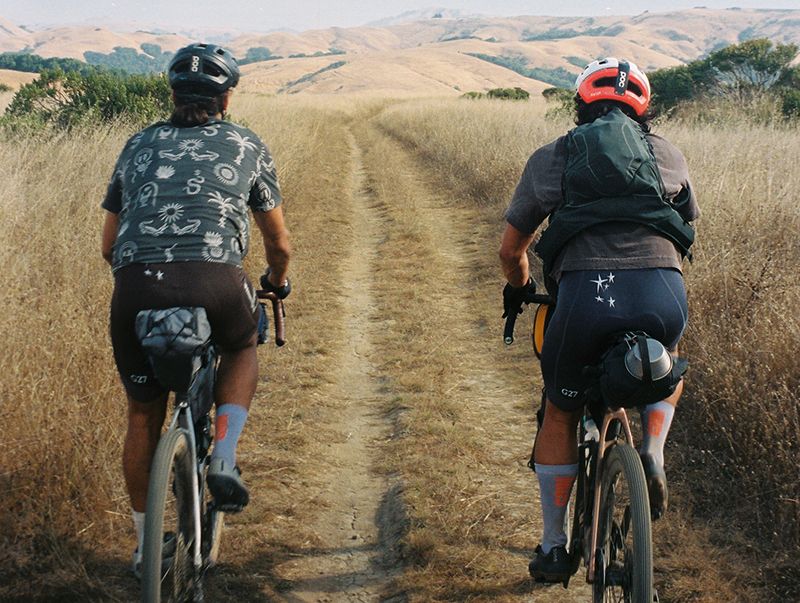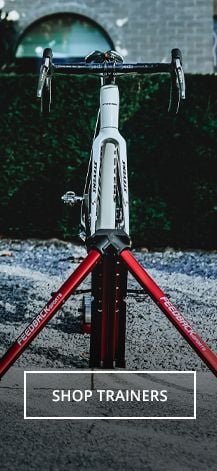
The American bicycle racing landscape has changed with the popularity of gravel bikes and gravel racing exploding in recent years. This relatively new discipline has been gaining momentum for some time. With fewer paved road races, changing technology, and busier roads, it's no surprise that more cyclists are taking up gravel.
Gravel is nothing new, we've been riding "gravel" for as long as we've had bikes and roads to ride them on. So what's changed? A lot! The bikes, tires, clothing, you name it. It's all been designed with the gravel rider in mind.
Gravel racing involves riding your bike on a course consisting of multi-surface roads, primarily gravel or dirt. Some courses even combine sections of singletrack or rugged double track meant for all-terrain vehicles. The variation in course and terrain you can expect in any given race makes racing gravel more dynamic and heightens the importance of planning for an event and selecting your gear.
Unlike in road racing, most gravel races don't use a category system to divide riders based on ability or experience. Everyone competing in a given distance races together, pros, beginners, and everyone in between (which is pretty cool). We are starting to see the emergence of a "Pro" field at some of the marquee events on the calendar, but it remains to be seen whether the discipline more broadly follows suit.
Distances in gravel races also vary considerably. For most gravel events, you can expect to choose from a short (~20-30 miles), medium (~50-60 miles), or long (~80-100 miles) course. Some include even longer race distances such as UNBOUND Gravel's 200-mile distance or their XL race that challenges riders to tackle 350 miles in a single event.
While most gravel events don't exceed 100 miles in a single go, adventure and ultra-cycling events (like the aforementioned UNBOUND XL or the 2,745 mile Tour Divide) are an emerging subcategory of gravel where riders tackle epic distances largely self-supported. We won't go in-depth on these longer events here, but if you're interested in multi-day adventures check out our tips for bikepacking.


Tori Duhaime
Given the length of these races, and the added difficulty of unpaved surfaces, nutrition and hydration are fundamental to dial-in. Unlike a road race, where there might be a feed zone with water, most gravel races will have some kind of aid stop with food, water, and frequently sponsored sports nutrition products for you to refuel throughout the route, similar to those you might find at a Gran Fondo event. If you're "racing" the event, it may not be advantageous to stop at these aid stations to refuel as you could lose precious time against your competitors. Some events do not have aid stations, so it's important to think ahead and prepare a fueling strategy.
This raises the fundamental question of "the spirit of gravel": are you there to ride it or are you there to race it? We'll leave that one for you to decide.
Here's what you need:
The Bike
Every gravel course offers something different. You might find yourself cruising along smooth hardpack dirt roads or slogging through a sticky mud pit for hours. While this may make bike selection sound a bit tricky, the bottom line is you need a bike with ample tire clearance and appropriate gearing for your intended use.
Today's gravel bike will come with considerably wider tire clearance (40-55mm) than a modern road bike (up to 35mm generally). Innovations in wheel and tire technology have pushed bike manufacturers to design frames that accommodate wider tires for better aerodynamics and improved performance over paved and unpaved surfaces.

3T Bike
Most gravel bikes come equipped with a 1x drivetrain: a single narrow wide chainring and a wide-ranging cassette to limit the risk of mechanicals in the field and still offer a rider the most complete gear selection. Depending on the course and elevation profile, riders may adjust their gear selection to match the terrain. For instance, on a course with less climbing, a narrower range of gears can lessen the jump from gear to gear. Whereas on a course with more elevation gain, a wider range of gears will help tackle steep climbs and keep fatigue low. Generally, gravel gearing gives the rider lower (easier) gears to choose from as it takes more power to ride over unpaved surfaces.

SRAM
Gravel bikes are similar to road bikes in terms of their geometry (although frequently with slacker front-ends) and are designed to be as efficient as possible while providing a higher degree of comfort over unpaved surfaces. Just like their road bike counterparts, some gravel bikes will be more aggressive and competition-oriented, and some will be more endurance-focused.
While gravel bikes are purpose-built for the conditions, that doesn't mean you can't get out there on a different bike. Before "gravel bikes" existed, cyclocross bikes were tackling the same roads and trails—and they still do the trick! On the other hand, if you're connecting a lot of singletrack or doubletrack, or riding exceptionally rough forest roads, a hardtail mountain bike can also be a sensible choice.
Tires, Tires, Tires
Arguably the most important detail, no matter what specific bike you bring, is tire choice. There are so many options on the market that it can seem overwhelming, but it doesn't need to be. It comes down to three factors: width, tread, and weight.
Let's start with the basics. Where are you riding? What are the demands of the course? Are the surfaces smooth and fast, or loose and chunky? The answer to these questions will lead you to tire width and tread pattern. A wider tire will give you more contact points with whatever surface you are on, allow you to run lower tire pressure, and absorb more of the roughness of the terrain. A narrower tire will have less rolling resistance over smooth, hardpack surfaces, but you'll need to run higher pressures to limit the risk of rim strikes and potential tire damage. 700x40mm is a popular choice for gravel because it balances the necessity of high volume and lower rolling resistance.
The next consideration is the tread pattern. As with mountain bike tires, beefy, knobby treads will give you better traction on loose or muddy surfaces, but they may not roll as fast on hardpack dirt or pavement as a slick or semi-slick tread. This is why tire selection is so important when entering a gravel race or tackling a big day on the bike. If the course includes a plurality of paved roads, you may want to choose a faster tire that balances these demands. Inversely, if you know that you'll have to ride a lot of singletrack or weather conditions call for rain, a tire with widely spaced knobs can make all the difference.


Bertrand Mejia-Morin (left), Cadex (right)
The final factor, which is heavily dependent on the first two, is weight. If you're chasing every marginal gain for the best result possible, a heavy tire can hold you back. But going too light may result in a catastrophic puncture. Something to note when shopping for a tire is the thread per inch (TPI). A tire with a high TPI will be lighter and offer a more supple ride, while lower TPI tires are generally heavier and more puncture-resistant.
The common thread here (pun intended) is that making the most optimal tire selection relies on knowing the course and the conditions of the surface. Our Tire Finder is a great tool to help find the tire you're looking for from our selection. If you've got more specific questions about tires and what to run on the day, give us a call.
Fueling Strategy
Now that you've got your bike and tire setup dialed in, let's talk about what your body needs to perform: fuel, and lots of it. Gravel races are incredibly physically demanding at every skill level and the last thing you want is to run out of energy before reaching the finish line.
Nutrition is a bit different for everybody, so we suggest figuring out what works best for you well in advance of your target event. Gels, chews, and bars are great ways to get sustained energy during the ride, but you can also increase your access to quick calories with a fast-absorbing carbohydrate drink mix. Knowing when to eat and what type of food source is also important to figure out for your nutrition plan. At the later stages of a race, it may be harder to take on solid foods as opposed to gels or drink mixes.

Skratch Labs
In a longer gravel race, a hydration pack can be a huge advantage for maintaining your hydration across rough surfaces. These packs are also great as extra storage for nutrition or tools. This brings us to our last point about what you need for a gravel race.
Tools (Just In Case)
The potential for catastrophe in a gravel race is high. Whether a mechanical, a flat, or some combination of both, you should be prepared for any mishap that might occur in the field. At the same time, you don't want to carry extra weight, so it's best to keep your repair kit paired down to the essentials: two tubes, tubeless plugs, a multi-tool, and some form of inflation device.


Wil Matthews (left), FSA-Vision (right)
Race Day!
Race day can be a healthy mix of excitement and nerves. Just remember: it's all about having fun at every level.
Be sure to give yourself a little extra time in the morning so you don't have to rush to get to the start line. When you arrive at the venue, you can expect to pick up your race number (or bib plate as it's sometimes called) at the registration booth. Most gravel events have a handlebar number and a jersey number. Make sure to double-check which side you need to pin your number on your jersey.
Once that's done and you're kitted up, check over your bike, make sure everything is set, and dial in your tire pressure. It's usually a good idea to spend some time warming up, especially if you are there to race hard. Give yourself about twenty minutes of warm-up on the road or a trainer. Plan to arrive at the start corral (where they send the riders off) at least ten minutes before the start of the race.
The start of a gravel race can be hectic so be prepared for some intensity right away. Once the pace settles down you'll be able to find your rhythm and settle into the race. If you find the going gets tough, keep going because the reward of crossing the finish line awaits you—and so too all of the wonderful sensations of completing a challenging day of cycling!

Vittoria Tires
How To Find A Race
Now that you know what to expect from gravel racing, it's time to find a race. There are a few resources that you can use to find a gravel race near you.
A great place to start looking for races across the United States is BikeReg where you can search for races by discipline, region, and date. Be sure to check out USA Cycling as well as for some sanctioned gravel races you may need to purchase a one-day or annual USA Cycling license. Not all gravel events require you to have a racing license so that's another important detail to confirm before you arrive on race day.
If you live in Oregon, where we are located, we encourage you to become an Oregon Bike Racing Association member and check out some of the great local gravel events in our neck of the woods.
And of course, one of the best places to learn about events in your area is by coming out on group rides and checking in with your local cycling community.
We hope to see you out there!
#ridewithbtd
Words by Emmett Culp

Tori Duhaime



















